2022 HYUNDAI TUCSON HYBRID trailer
[x] Cancel search: trailerPage 489 of 630
![HYUNDAI TUCSON HYBRID 2022 Owners Manual Driver assistance system
7-130
• Pulling into the parking space where
there is a structure
OJX1079115[A] : Structure, [B] :Wall
Rear Cross-Traffic Safety system
may detect vehicles passing by in HYUNDAI TUCSON HYBRID 2022 Owners Manual Driver assistance system
7-130
• Pulling into the parking space where
there is a structure
OJX1079115[A] : Structure, [B] :Wall
Rear Cross-Traffic Safety system
may detect vehicles passing by in](/manual-img/35/56198/w960_56198-488.png)
Driver assistance system
7-130
• Pulling into the parking space where
there is a structure
OJX1079115[A] : Structure, [B] :Wall
Rear Cross-Traffic Safety system
may detect vehicles passing by in
front of you when parking in reverse
into a parking space with a wall or
structure in the rear or side area.
If this occurs, the function may
unnecessarily warn the driver and
control the brake.
Always check your surroundings
while backing up. •
When the vehicle is parked rearward
OJX1079116
Rear Cross-Traffic Safety system may
detect vehicles passing by behind
you when parking in reverse into
a parking space. If this occurs, the
function may unnecessarily warn the
driver and control the brake.
Always check your surroundings
while backing up.
WARNING
• When you are towing a trailer or
another vehicle, we recommend that
Rear Cross-Traffic Safety system is
turned off due to safety reasons.
• Rear Cross-Traffic Safety system may
not operate normally if interfered by
strong electromagnetic waves.
• Rear Cross-Traffic Safety system may
not operate for 3 seconds after the
vehicle is started, or the rear corner
radars are initialized.
Page 504 of 630
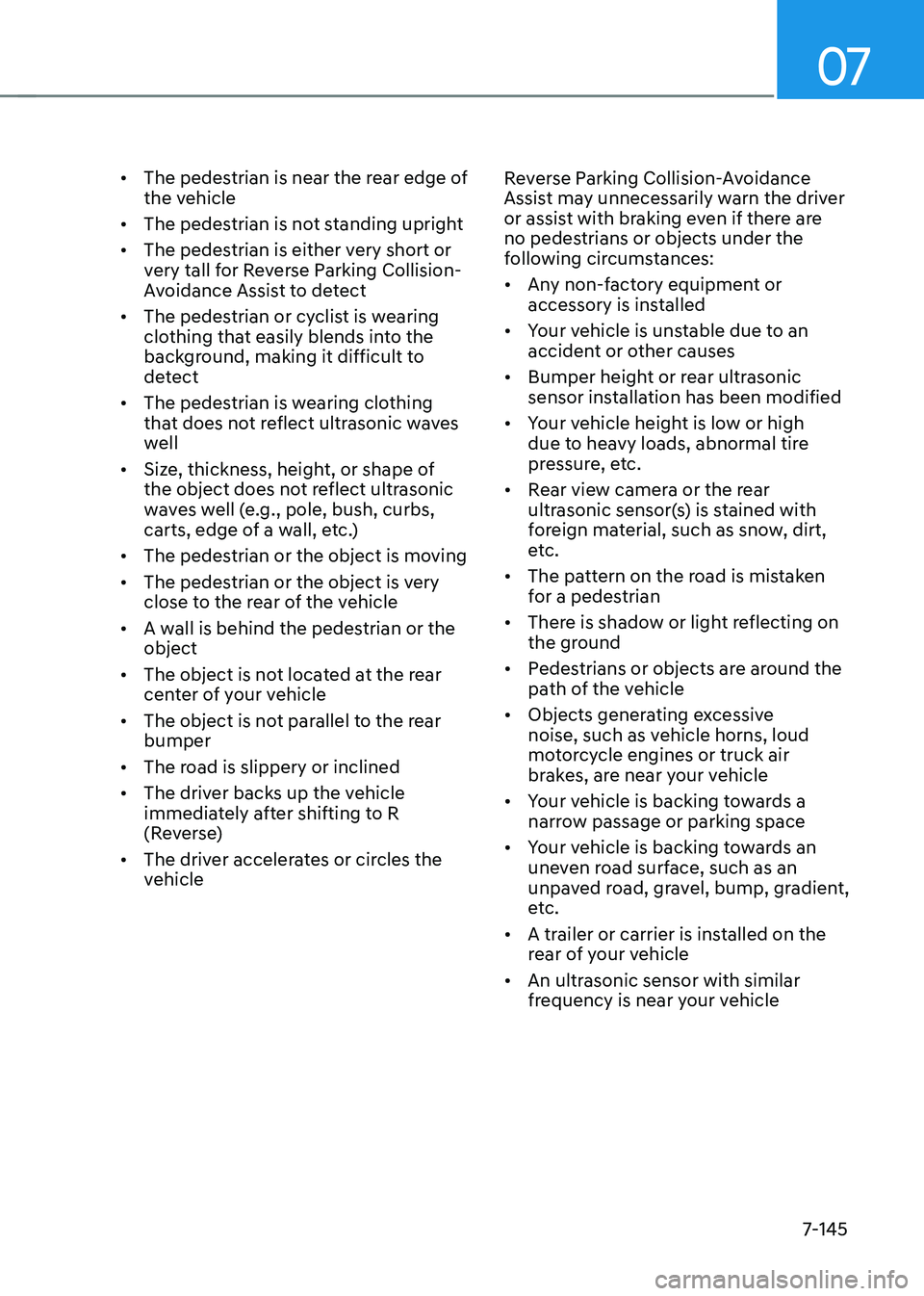
07
7-145
• The pedestrian is near the rear edge of
the vehicle
• The pedestrian is not standing upright
• The pedestrian is either very short or
very tall for Reverse Parking Collision-
Avoidance Assist to detect
• The pedestrian or cyclist is wearing
clothing that easily blends into the
background, making it difficult to
detect
• The pedestrian is wearing clothing
that does not reflect ultrasonic waves
well
• Size, thickness, height, or shape of
the object does not reflect ultrasonic
waves well (e.g., pole, bush, curbs,
carts, edge of a wall, etc.)
• The pedestrian or the object is moving
• The pedestrian or the object is very
close to the rear of the vehicle
• A wall is behind the pedestrian or the
object
• The object is not located at the rear
center of your vehicle
• The object is not parallel to the rear
bumper
• The road is slippery or inclined
• The driver backs up the vehicle
immediately after shifting to R
(Reverse)
• The driver accelerates or circles the
vehicle Reverse Parking Collision-Avoidance
Assist may unnecessarily warn the driver
or assist with braking even if there are
no pedestrians or objects under the
following circumstances:
•
Any non-factory equipment or
accessory is installed
• Your vehicle is unstable due to an
accident or other causes
• Bumper height or rear ultrasonic
sensor installation has been modified
• Your vehicle height is low or high
due to heavy loads, abnormal tire
pressure, etc.
• Rear view camera or the rear
ultrasonic sensor(s) is stained with
foreign material, such as snow, dirt,
etc.
• The pattern on the road is mistaken
for a pedestrian
• There is shadow or light reflecting on
the ground
• Pedestrians or objects are around the
path of the vehicle
• Objects generating excessive
noise, such as vehicle horns, loud
motorcycle engines or truck air
brakes, are near your vehicle
• Your vehicle is backing towards a
narrow passage or parking space
• Your vehicle is backing towards an
uneven road surface, such as an
unpaved road, gravel, bump, gradient,
etc.
• A trailer or carrier is installed on the
rear of your vehicle
• An ultrasonic sensor with similar
frequency is near your vehicle
Page 505 of 630
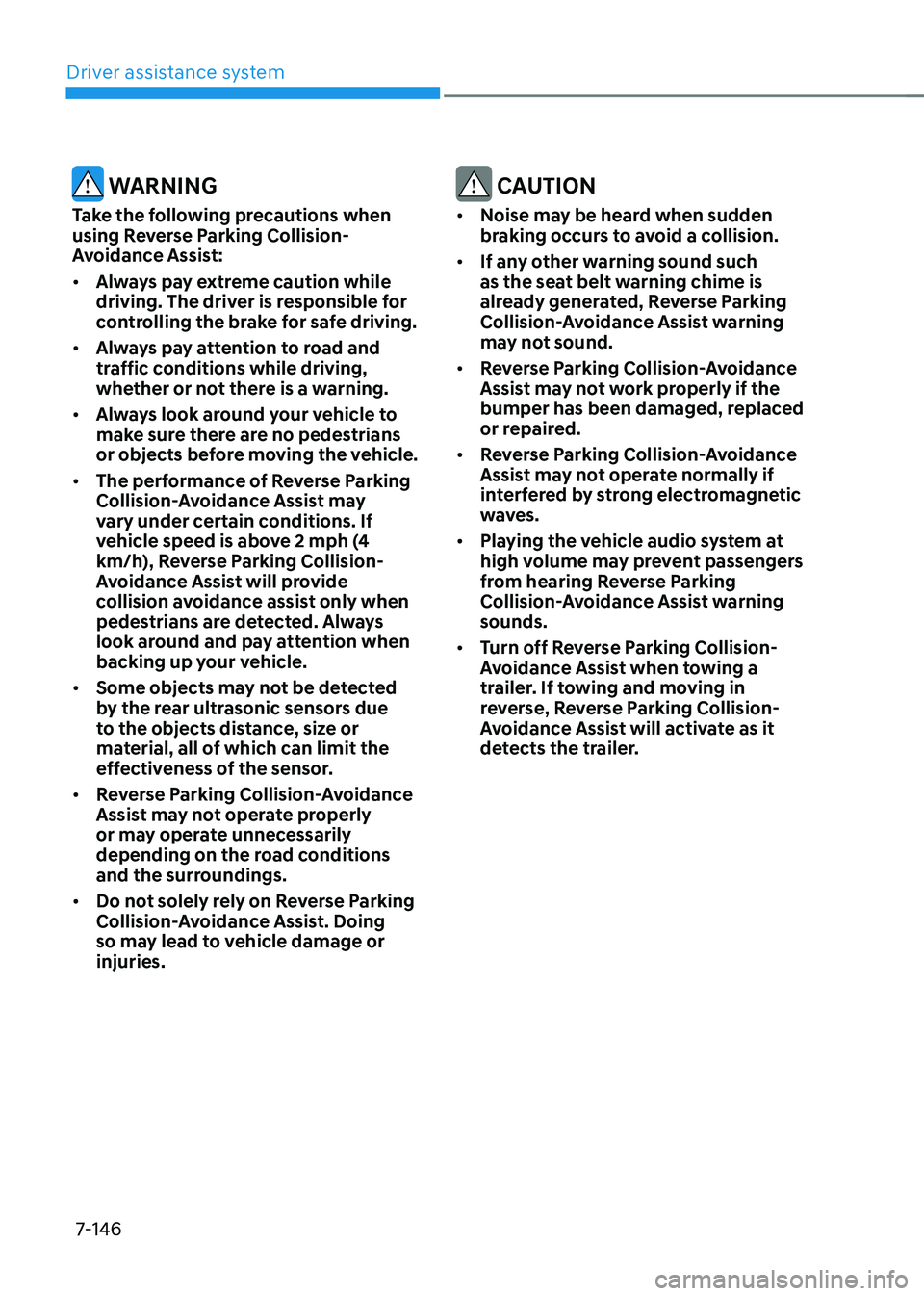
Driver assistance system
7-146
WARNING
Take the following precautions when
using Reverse Parking Collision-
Avoidance Assist:
• Always pay extreme caution while
driving. The driver is responsible for
controlling the brake for safe driving.
• Always pay attention to road and
traffic conditions while driving,
whether or not there is a warning.
• Always look around your vehicle to
make sure there are no pedestrians
or objects before moving the vehicle.
• The performance of Reverse Parking
Collision-Avoidance Assist may
vary under certain conditions. If
vehicle speed is above 2 mph (4
km/h), Reverse Parking Collision-
Avoidance Assist will provide
collision avoidance assist only when
pedestrians are detected. Always
look around and pay attention when
backing up your vehicle.
• Some objects may not be detected
by the rear ultrasonic sensors due
to the objects distance, size or
material, all of which can limit the
effectiveness of the sensor.
• Reverse Parking Collision-Avoidance
Assist may not operate properly
or may operate unnecessarily
depending on the road conditions
and the surroundings.
• Do not solely rely on Reverse Parking
Collision-Avoidance Assist. Doing
so may lead to vehicle damage or
injuries.
CAUTION
• Noise may be heard when sudden
braking occurs to avoid a collision.
• If any other warning sound such
as the seat belt warning chime is
already generated, Reverse Parking
Collision-Avoidance Assist warning
may not sound.
• Reverse Parking Collision-Avoidance
Assist may not work properly if the
bumper has been damaged, replaced
or repaired.
• Reverse Parking Collision-Avoidance
Assist may not operate normally if
interfered by strong electromagnetic
waves.
• Playing the vehicle audio system at
high volume may prevent passengers
from hearing Reverse Parking
Collision-Avoidance Assist warning
sounds.
• Turn off Reverse Parking Collision-
Avoidance Assist when towing a
trailer. If towing and moving in
reverse, Reverse Parking Collision-
Avoidance Assist will activate as it
detects the trailer.
Page 516 of 630

07
7-157
OTM070221L
Remote Smart Parking Assist standby
When ‘Parking Assist Conditions Not
Met’
message appear
s,
when P
arking/
View (
) button has been pressed and
held, Remote Smart Parking Assist is in
standby. After a while, press and hold the
Parking/View (
) button again to see if
Remote Smart Parking Assist works.
The message appears even when the
smart key's battery is low. Check the
smart key battery level.
Limitations of Remote Smart Parking
Assist
In the following circumstances, Remote
Smart Parking Assist performance to
park or exit the vehicle may be limited,
there may be a risk of collision, or
Remote Smart Parking Assist may turn
off. Park or exit the vehicle manually if
necessary.
• An object is attached to the steering
wheel
• The vehicle is installed with a snow
chain, spare tire or different size
wheel
• Tire pressure is lower or higher than
the standard tire pressure
• Your vehicle is loaded with cargo
longer or wider than your vehicle or a
trailer is connected to your vehicle
• There is a problem with the wheel
alignment
• Your vehicle is leaned severely to one
side
• Your vehicle is equipped with a trailer
hitch
• The license plate is installed
differently from the original location
• There is a person, animal or object
above or below the ultrasonic sensor
when Remote Smart Parking Assist is
activated
• The parking space is curved or
diagonal
• There is an obstacle such as a person,
animal or object (trash can, bicycle,
motorcycle, shopping cart, narrow
pillar etc.) near the parking space
Page 535 of 630
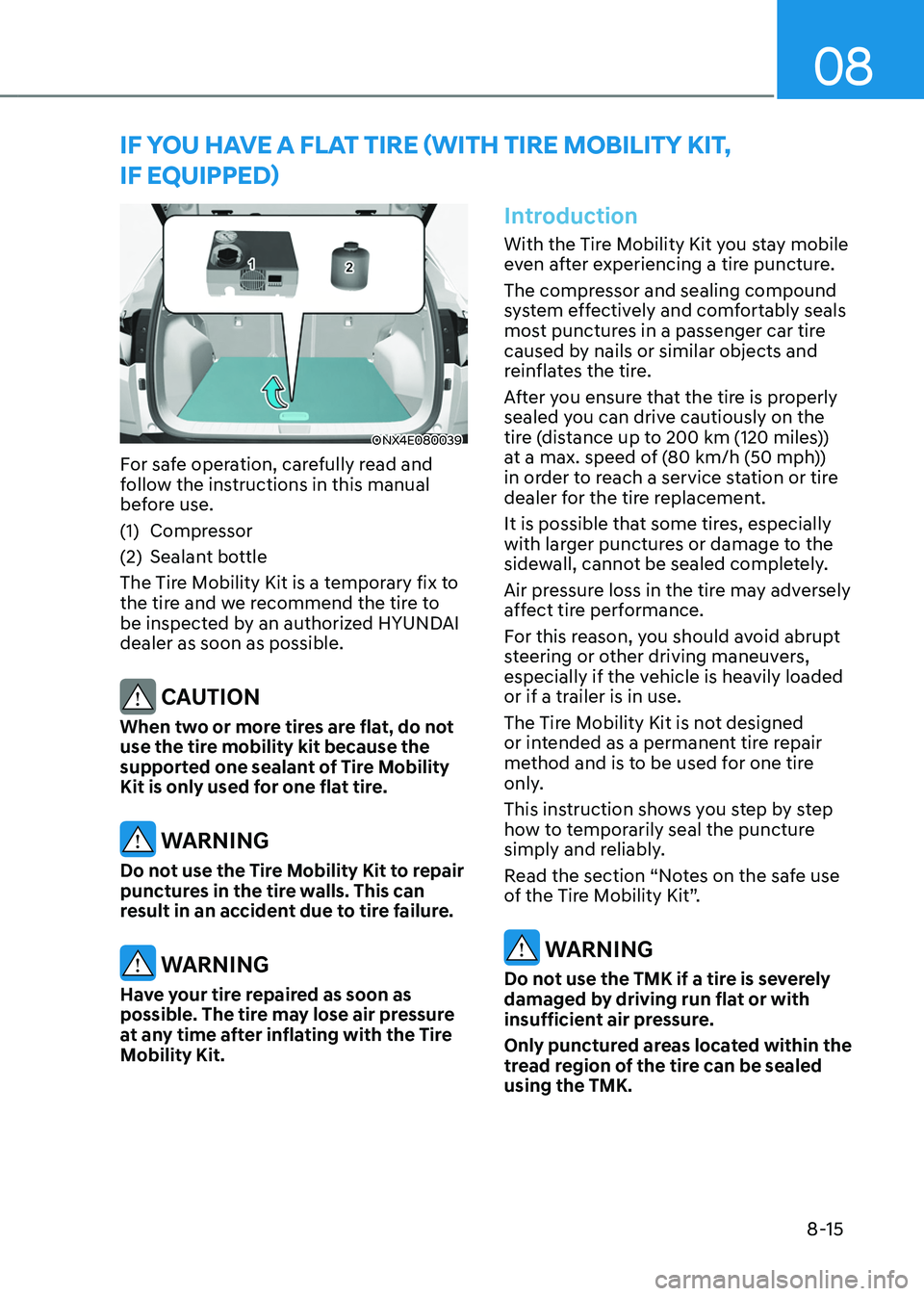
08
8-15
if you have a flaT Tire (wiTh Tire MobiliTy KiT,
if e qui
PPed)
ONX4E080039
For safe operation, carefully read and
follow the instructions in this manual
before use.
(1)
Compressor
(2)
Sealant bo
ttle
The Tire Mobility Kit is a temporary fix to
the tire and we recommend the tire to
be inspected by an authorized HYUNDAI
dealer as soon as possible.
CAUTION
When two or more tires are flat, do not
use the tire mobility kit because the
supported one sealant of Tire Mobility
Kit is only used for one flat tire.
WARNING
Do not use the Tire Mobility Kit to repair
punctures in the tire walls. This can
result in an accident due to tire failure.
WARNING
Have your tire repaired as soon as
possible. The tire may lose air pressure
at any time after inflating with the Tire
Mobility Kit.
Introduction
With the Tire Mobility Kit you stay mobile
even after experiencing a tire puncture.
The compressor and sealing compound
system effectively and comfortably seals
most punctures in a passenger car tire
caused by nails or similar objects and
reinflates the tire.
After you ensure that the tire is properly
sealed you can drive cautiously on the
tire (distance up to 200 km (120 miles))
at a max. speed of (80 km/h (50 mph))
in order to reach a service station or tire
dealer for the tire replacement.
It is possible that some tires, especially
with larger punctures or damage to the
sidewall, cannot be sealed completely.
Air pressure loss in the tire may adversely
affect tire performance.
For this reason, you should avoid abrupt
steering or other driving maneuvers,
especially if the vehicle is heavily loaded
or if a trailer is in use.
The Tire Mobility Kit is not designed
or intended as a permanent tire repair
method and is to be used for one tire
only.
This instruction shows you step by step
how to temporarily seal the puncture
simply and reliably.
Read the section “Notes on the safe use
of the Tire Mobility Kit”.
WARNING
Do not use the TMK if a tire is severely
damaged by driving run flat or with
insufficient air pressure.
Only punctured areas located within the
tread region of the tire can be sealed
using the TMK.
Page 595 of 630
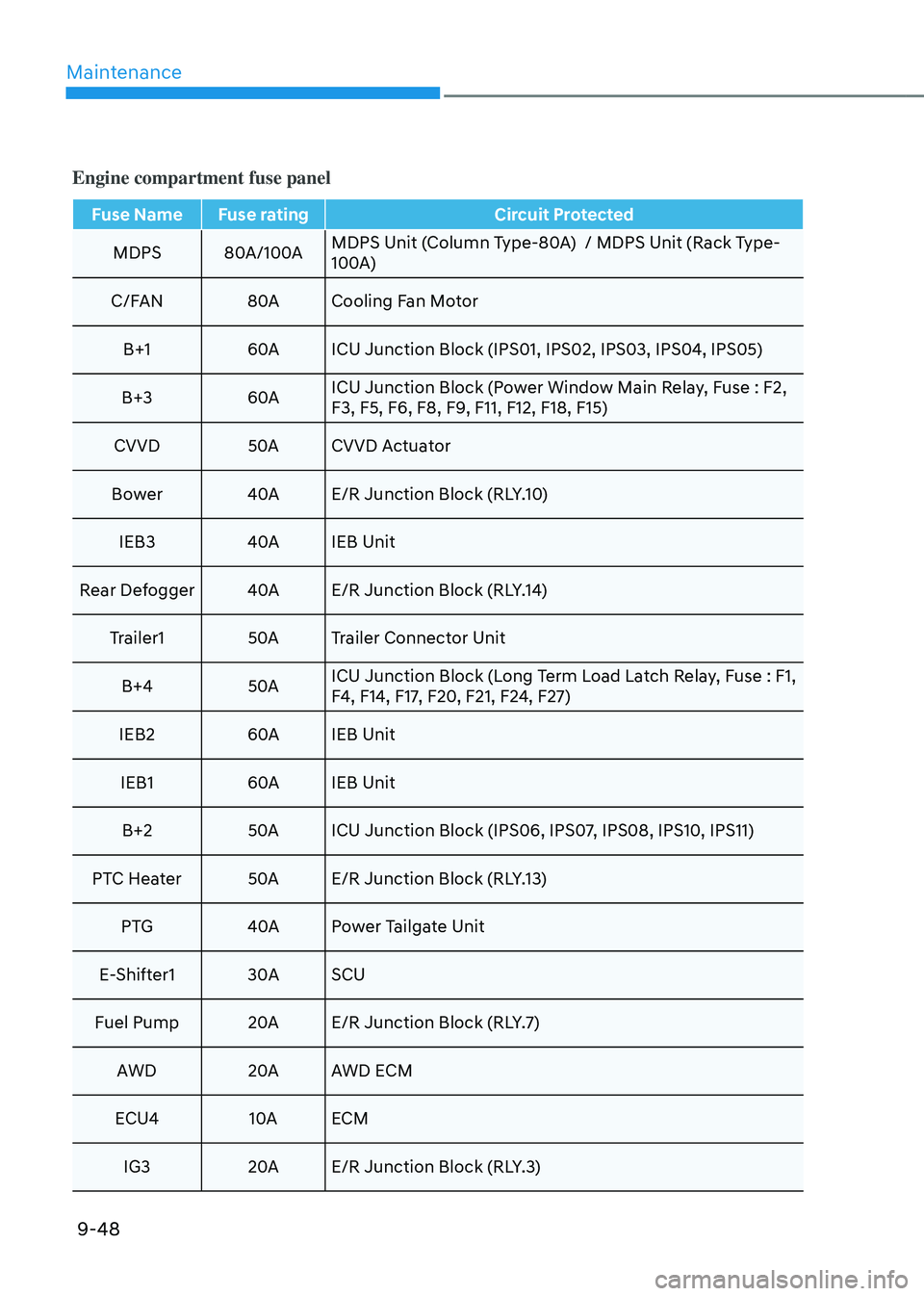
Maintenance
9-48
Engine compartment fuse panel
Fuse Name Fuse ratingCircuit Protected
MDPS 80A/100A MDPS Unit (Column Type-80A) / MDPS Unit (Rack Type-
100A)
C/FAN 80ACooling Fan Motor
B+1 60AICU Junction Block (IPS01, IPS02, IPS03, IPS04, IPS05)
B+3 60AICU Junction Block (Power Window Main Relay, Fuse : F2,
F3, F5, F6, F8, F9, F11, F12, F18, F15)
CVVD 50ACVVD Actuator
Bower 40AE/R Junction Block (RLY.10)
IEB3 40AIEB Unit
Rear Defogger 40AE/R Junction Block (RLY.14)
Trailer1 50ATrailer Connector Unit
B+4 50AICU Junction Block (Long Term Load Latch Relay, Fuse : F1,
F4, F14, F17, F20, F21, F24, F27)
IEB2 60AIEB Unit
IEB1 60AIEB Unit
B+2 50AICU Junction Block (IPS06, IPS07, IPS08, IPS10, IPS11)
PTC Heater 50AE/R Junction Block (RLY.13)
PTG 40APower Tailgate Unit
E-Shifter1 30ASCU
Fuel Pump 20AE/R Junction Block (RLY.7)
AWD 20AAWD ECM
ECU4 10AECM
IG3 20AE/R Junction Block (RLY.3)
Page 596 of 630
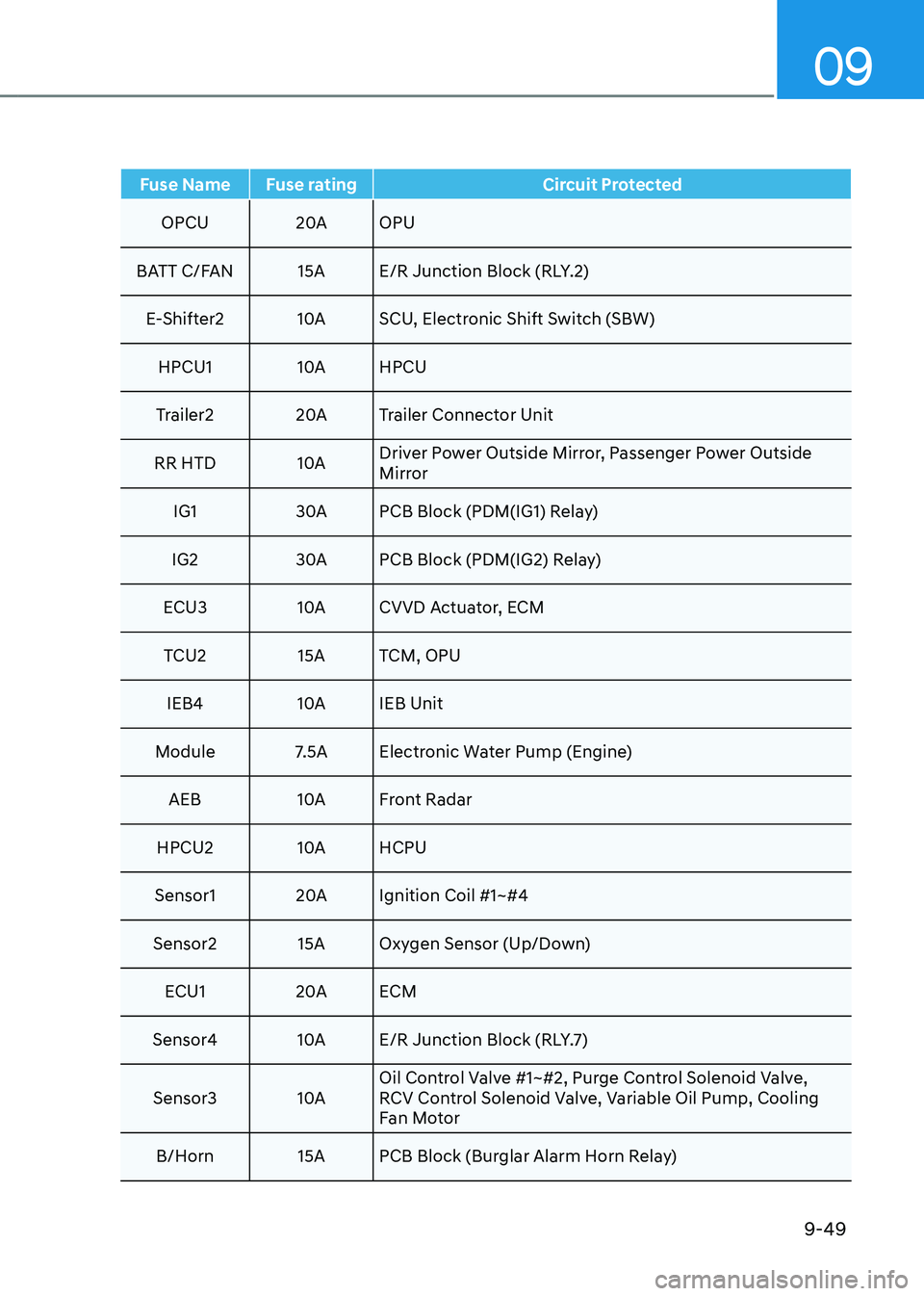
09
9-49
Fuse Name Fuse ratingCircuit Protected
OPCU 20AOPU
BATT C/FAN 15A E/R Junction Block (RLY.2) E-Shifter2 10ASCU, Electronic Shift Switch (SBW)
HPCU1 10AHPCU
Trailer2 20ATrailer Connector Unit
RR HTD 10ADriver Power Outside Mirror, Passenger Power Outside
Mirror
IG1 30APCB Block (PDM(IG1) Relay)
IG2 30APCB Block (PDM(IG2) Relay)
ECU3 10ACVVD Actuator, ECM
TCU2 15A TCM, OPU
IEB4 10AIEB Unit
Module 7.5A Electronic Water Pump (Engine) AEB 10AFront Radar
HPCU2 10AHCPU
Sensor1 20AIgnition Coil #1~#4
Sensor2 15A Oxygen Sensor (Up/Down) ECU1 20AECM
Sensor4 10AE/R Junction Block (RLY.7)
Sensor3 10AOil Control Valve #1~#2, Purge Control Solenoid Valve,
RCV Control Solenoid Valve, Variable Oil Pump, Cooling
Fan Motor
B/Horn 15A PCB Block (Burglar Alarm Horn Relay)
Page 620 of 630

I
I-3
A
Battery
........................................................................\
.........................................9-28
Before Jump Starting ........................................................................\
..................8-5
Jump Starting........................................................................\
..............................8-6
Before driving
........................................................................\
................................6-4
Before entering the vehicle ........................................................................\
........6-4
Before starting ........................................................................\
............................6-4
Blind-Spot Collision Warning (BCW)
................................................................7-23
System malfunction and limitations .................................................................7-28
System operation ........................................................................\
......................7-26
System settings ........................................................................\
.........................7-24
Blind-Spot Collision-Avoidance Assist (BCA)
...................................................7-32
System malfunction and limitations .................................................................7-41
System operation ........................................................................\
......................7-36
System settings ........................................................................\
.........................7-34
Blind-Spot View Monitor (BVM)
.......................................................................7-63
System malfunction ........................................................................\
..................7-64
System operation ........................................................................\
......................7-63
System settings ........................................................................\
.........................7-63
Brake fluid
........................................................................\
...................................9-20
Checking the brake fluid level ........................................................................\
.9-20
Braking system
........................................................................\
............................6-21
Anti-lock Brake System (ABS) ........................................................................\
6-30
Auto Hold ........................................................................\
.................................6-26
Disc brakes wear indicator ........................................................................\
.......6-22
Downhill Brake Control (DBC) ......................................................................6-36
Electronic Parking Brake (EPB) ......................................................................6-22
Electronic Stability Control (ESC) ...................................................................6-31
Good braking practices ........................................................................\
.............6-39
Hill-Start Assist Control (HAC) ......................................................................6-35
Power brakes ........................................................................\
............................6-21
Trailer Stability Assist (TSA) ........................................................................\
..6-36
Vehicle Stability Management (VSM) ............................................................6-34
Bulb wattage
........................................................................\
..................................2-9